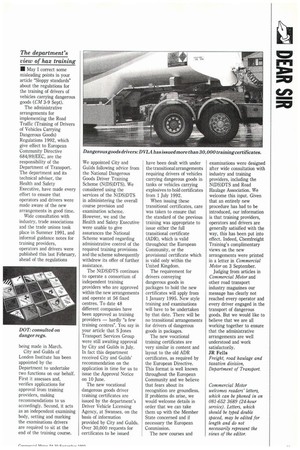The department's view of haz training
Page 41

If you've noticed an error in this article please click here to report it so we can fix it.
May I correct some misleading points in your article "Sloppy standards" about the regulations for the training of drivers of vehicles carrying dangerous goods (CM 3-9 Sept).
The administrative arrangements for implementing the Road Traffic (Training of Drivers of Vehicles Carrying Dangerous Goods) Regulations 1992, which give effect to European Community Directive 684/89/EEC, are the responsibility of the Department of Transport. The department and its technical adviser, the Health and Safety Executive, have made every effort to ensure that operators and drivers were made aware of the new arrangements in good time.
Wide consultation with industry, trade associations and the trade unions took place in Summer 1991, and informal guidance notes for training providers, operators and drivers were published this last February, ahead of the regulations being made in March.
City and Guilds of London Institute has been appointed by the Department to undertake two functions on our behalf. First it assesses and, verifies applications for approval from training providers, making recommendations to us accordingly. Second, it acts as an independent examining body, setting and marking the examinations drivers are required to sit at the end of the training course.
We appointed City and Guilds following advice from the National Dangerous Goods Driver Training Scheme (N(DS)DTS). We considered using the services of the N(DS)DTS in administering the overall course provision and examination scheme. However, we and the Health and Safety Executive were unable to give assurances the National Scheme wanted regarding administrative control of the required training provisions and the scheme subsequently withdrew its offer of further assistance.
The N(DS)DTS continues to operate a consortium of independent training providers who are approved within the new arrangements and operate at 56 fixed centres. To date 48 different companies have been approved as training providers — hardly "a few training centres". You say in your article that S Jones Transport Services Group were still awaiting approval by City and Guilds in July. In fact this department received City and Guilds' recommendation on the application in time for us to issue the Approval Notice on 10 June.
The new vocational dangerous goods driver training certificates are issued by the department's Driver Vehicle Licensing Agency, at Swansea, on the basis of information provided by City and Guilds. Over 30,000 requests for certificates to be issued
have been dealt with under the transitional arrangements requiring drivers of vehicles carrying dangerous goods in tanks or vehicles carrying explosives to hold certificates from 1 July 1992.
When issuing these transitional certificates, care was taken to ensure that the standard of the previous training was appropriate to issue either the full transitional certificate (ADR), which is valid throughbut the European Community, or the provisional certificate which is valid only within the United Kingdom.
The requirement for drivers conveying dangerous goods in packages to hold the new certificates will apply from 1 January 1995. New style training and examinations will have to be undertaken by that date. There will be no transitional arrangements for drivers of dangerous goods in packages.
The new vocational training certificates are very similar in content and layout to the old ADR certificates, as required by the European Directive. This format is well known throughout the European Community and we believe that fears about its recognition are groundless. If problems do arise, we would welcome details in order that we can take them up with the Member State concerned and if necessary the European Commission.
The new courses and
examinations were designed after wide consultation with industry and training providers, including the N(DS)DTS and Road Haulage Association. We welcome this input. Given that an entirely new procedure has had to be introduced, our information is that training providers, operators and drivers are generally satisified with the way, this has been put into effect. Indeed, Chemfreight Training's complimentary views on the new arrangements were printed in a letter in Commercial Motor on 3 September.
Judging from articles in Commercial Motor and other road transport industry magazines our message has clearly not reached every operator and every driver engaged in the transport of dangerous goods. But we would like to believe that we are all working together to ensure that the administrative arrangements are well understood and work satisfactorily.
JR Fells Freight, road haulage and taxation division, Department of Transport.
Commercial Motor welcomes readers' letters, which can be phoned in on 081-652 3689 (24-hour service). Letters, which should be typed double spaced, may be edited for length and do not necessarily represent the views of the editor.








































































